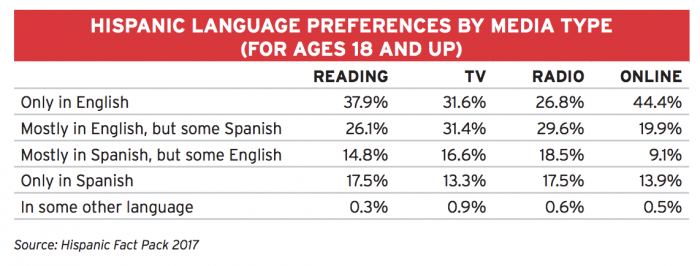“This is a fickle country. They take you in one generation and want to deport you the next,” Alfredo Corchado, the Dallas Morning News’ Mexico-U.S. border correspondent, said at a conference about covering the 2020 election last month.
Hispanic media in the U.S. serves one of the fastest-growing demographics in the country, but is trying to find its way as its customers’ habits and preferences shift. While newspapers’ circulation has fallen and accessible radio struggles to secure funding, some experiments in Spanish-language TV investments are bearing out. And digital media like Mitú (which describes its audience as “the 200 percent: youth who are 100 percent American and 100 percent Latino”) is working on straddling the divide between much of the older, Spanish-speaking generations who immigrated and younger generations who rely on the internet and seek media that reflect their own shared identities.
Well, that’s all according to a new report from Democracy Fund on the state of Hispanic media, assembled by California State University Northridge associate professor Jessica Retis. (She requested the interchangeable use of Hispanic and Latino in the report. We’ll follow that guideline here too.) This report joins others on the states of African-American media and American Indian media.Also relevant: The Craig Newmark Graduate School of Journalism at CUNY is working on a similar report, to be published next month. They have a handy map of the existing landscape out now.
“Latino media…must take into account the complex diversity of the Hispanic population, which means that local audiences can differ from the shared history and culture of the Spanish-speaking outlet which serves that region,” Retis writes. “In spite of these struggles, Hispanic media has weathered the downturn better than many mainstream media because of its deep connection to community.”
As the Hispanic population in the U.S. doubled in the 1980s and 1990s, Hispanic daily newspapers grew considerably in the 1990s and 2000s — but has seen circulation decline more than 10 percent over the past five years. Spanish-language television emerged as an attempt to serve the growing population (and export programming to Latin American countries). CNN’s Spanish-language news channel in the 1990s and Telemundo’s studio opening on the West Coast in 1995 attracted the interest of American mainstream media businesses. In 2010, Univision was the fifth-largest U.S. broadcast network by primetime audience share and was the only one to see positive audience growth of the top five.
But “Spanish-language” doesn’t fully cover the complex identities young Hispanic Americans hold today, according to Retis. More and more Spanish-language media companies are increasing English-language content (and vice versa for English-language businesses). Mitú launched on YouTube in 2012. The major companies like Telemundo and Univision have tried to bridge the gap as well, as Hispanic Americans ages 18 and older prefer English-language content online. (Univision did try English-language digital media — you might recall Gizmodo Media Group — but now keeps a small stable of English-language content.)
Here are the challenges and opportunities Retis identified for Hispanic media:
Challenges:
Recommendations:
Until recently, most professionals working in Spanish-language broadcast, print, and online newsrooms have been born and educated abroad, mostly in Mexico and other Latin American countries. Increasingly, new initiatives are being launched by journalism programs seeking to prepare bilingual and bicultural journalists. These young journalism students need opportunities for entering the job market….
Examples of current and former projects include: Spanish-language journalism programs and trainings at the Craig Newmark Graduate School of Journalism at the City University of New York, Florida International University, The Knight Center for Journalism at the University of Texas at Austin, California State University Northridge, Arizona State University, University of Texas at El Paso, and others.
The changes taking place within the Spanish-language and Latinx-oriented media have happened in parallel to the demographic shifts in the country and a corresponding rise of anti-immigrant and anti-Hispanic sentiment. Spanish-language media are important resources for information and self representation and can be an important resource for pushing back against anti-immigrant narratives that pervade some mainstream media….
Examples of current and former citizen-oversight projects include: The National Association of Hispanic Journalists’ Parity Project, which worked in more than 50 cities to combine citizen advisory boards, internship programs, and more to “increase the representation of Latinos in newsrooms and improve news coverage of the nation’s Latino community.” Currently, groups like The National Hispanic Media Coalition, Color of Change and the Media Action Grassroots Network monitor media and bring citizen voices to bear newsrooms and media companies
There is a growing need for linguistic and cultural translations between Hispanic and mainstream media to ensure that the information needs of Spanish speakers can be met, regardless of language barriers…. A news aggregator portal that could curate and translate online content for bilingual audiences would serve as a bridge across diverse communities….
Examples of current and former translation projects include: Voices of NY at the Center for Community and Ethnic Media, which curates and translates reporting from across the city’s community and ethnic publications. New America Media used to do some of this before recently closing its doors. Alahambra Source is a local newsroom reporting and translating stories in three languages for the community around Alahambra in Los Angeles County, California.
The full report is here.
Leave a comment